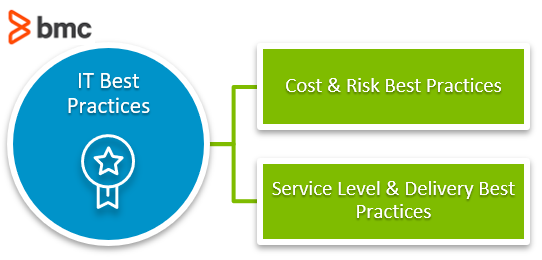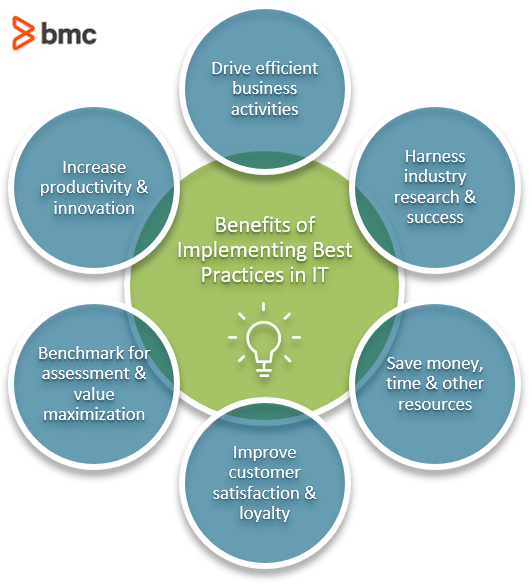Best practices help businesses improve services, products, security, and productivity while maximizing the value of investments. Integrating best practices into your business can be a difficult process but doing so comes with great savings on time and money, plus additional benefits like:
- Increased efficiency and productivity
- More satisfied and loyal customers
- Intentional innovation
Best practices are different within every field of IT, meaning that a project manager will have a different set of best practices than a developer working on the mainframe, for example. That doesn’t mean that they don’t have significant overlap, however.
Finding the best practices for you is key for your business success—and for your clients and customers to maximize value out of the services you offer. This roundup covers best practices from the cloud to mainframe development and beyond.
What are best practices?
Leading technology analyst firm Gartner defines best practices as:
A group of tasks that optimizes the efficiency (cost and risk) or effectiveness (service level) of the business discipline or process to which it contributes. It must be implementable, replicable, transferable and adaptable across industries.
Gartner identifies two kinds of best practices—those that address cost and risk and those that address the business at a service delivery level. Having processes and practices for both is key to success in your business.
Remember, though: Implementing best practices themselves is not the goal. Instead, you should implement best practices that can help your company in specific ways, with specific outcomes.

Cost & risk best practices
Managing the cost of projects is key to successful business. Without effective cost management and planning, you’ll overspend on your projects and need to renegotiate the appropriate payment—or risk losing money where you’re supposed to make it.
Cutting down on cost or risk overrun is difficult without effective and efficient best practices.
Adopting straightforward cost and risk best practices within your business will reduce the risk of:
- Overspending
- Overrunning deadlines
- Unhappy customers
As with most best practice implementations, the benefits might not be immediately evident, but you’ll see them in the long-term. Ideally, you’ll see improvements in how your business:
- Delivers your products and services
- Honors agreements
- Brings value to customers
Service level best practices
Many service level agreements (SLAs) fail because they are not implemented correctly. Even when businesses have the best practices for service management in theory, actual application of SLAs is sometimes more difficult. Failing to implement best practices at every stage will lead to people not holding up their end of the bargain or misunderstandings later in the project.
Using a robust SLA from a respected ITSM framework like COBIT or ITIL is one of the easiest ways to find success. Although the agreements themselves will change from contract to contract, understanding best practices can bring success to both you and your client.
Are best practices always the same?
Instead of being hard and fast rules to butt up against, best practices are there to inform us about how to get the most out of our money, service delivery, and customer support. This means that there is a degree of flexibility in best practices.
To get the most out of them, you’ll first want to understand the best practice. How can you use a best practice in a way that favours both the business and the client?
When thinking moves from “These are the rules that we must follow” to “How can we all maximize value?”, best practices will become key in every business discussion.

Benefits to using IT best practices
Of course, the whole goal of best practices is to drive business activities that provide value to your customers. Additionally, IT best practices can be used for benchmarking and self-assessment. They’re also what popular IT and service management frameworks are all built around, no matter the IT domain.
Good best practices go beyond templates and hard-and-fast rules, focusing instead on:
- Positive business outcomes
- Efficient adaption of historically valid guidelines
IT best practices support the business
Increasingly IT moves from simply delivering technology to the business to providing and driving business value. Is your IT up to the task?
BMC Blogs has many resources for understanding and implementing IT best practices. Explore our individual blogs, or dive deeper into these topical areas:
IT Operations & The IT Organization
Service Delivery & Management (ITSM)
- IT Service Management
- ITSM Implementation
- ITIL®
- ITIL 4 Guide
- ITIL v3 Guide
- COBIT Framework
- Service Availability
- High Availability
- Service Level Agreements (SLAs)
- Knowledge Management
- Software Asset Management
- Hardware Asset Management
Service Desk
Mainframe
Security
- IT Security Policy
- The MITRE ATT&CK Framework
- Enterprise Password Management
Cloud
DevOps
- Software Project Management
- DevOps Testing
- Quality Assurance (QA) in Software Testing
- Serverless
- Building a Microservices Architecture
- AWS Well-Architected Framework
- Container Security
- Kubernetes Cluster Efficiency
- Docker Security
Data
The Business
- Digital Transformation
- SMART Goals
- Organizational Change Management
- Workplace BYOD (Bring Your Own Device)
See how BMC can support your IT journey:
These postings are my own and do not necessarily represent BMC's position, strategies, or opinion.
See an error or have a suggestion? Please let us know by emailing blogs@bmc.com.






